
Utrecht Caravaggism refers to the work of a group of artists who were from, or had studied in, the Dutch city of Utrecht, and during their stay in Rome during the early seventeenth century had become distinctly influenced by the art of Caravaggio. Upon their return to the Dutch Republic, they worked in a so-called Caravaggist style, which in turn influenced an earlier generation of local artists as well as artists in Flanders. The key figures in the movement were Hendrick ter Brugghen, Gerrit van Honthorst and Dirck van Baburen, who introduced Caravaggism into Utrecht painting around 1620. After 1630 the artists moved in other directions and the movement petered out. The Utrecht Caravaggisti painted predominantly history scenes and genre scenes executed in a realist style.
Supper at Emmaus is an event in the Gospel of Luke.

Matthias Stom or Matthias Stomer was a Dutch, or possibly Flemish, painter who is only known for the works he produced during his residence in Italy. He was influenced by the work of non-Italian followers of Caravaggio in Italy, in particular his Dutch followers often referred to as the Utrecht Caravaggists, as well as by Jusepe de Ribera and Peter Paul Rubens. He did not share the other Northern Caravaggisti's preference for humorous, and sometimes scabrous, genre scenes and elaborate decorative allegories but favored stories from the bible instead. He worked in various locations in Italy where he enjoyed the patronage of religious institutions as well as prominent members of the nobility.

Jacques de l'Ange or the Monogrammist JAD was a Flemish painter and draughtsman known for his genre scenes and history paintings executed in a Caravaggesque style. The artist was only rediscovered in the mid-1990s as his work was previously attributed to other Northern Caravaggists and in particular the Utrecht School Caravaggists or Flemish Carravagists.

Saint Rosalie Interceding for the Plague-stricken of Palermo is a painting of 1624 by Anthony van Dyck, in the Metropolitan Museum of Art in New York since 1871.
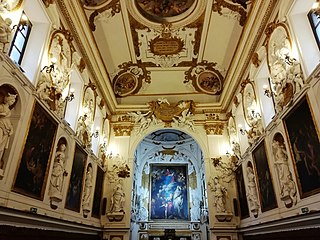
The Oratory of the Rosary of Saint Dominic is a Baroque oratory of Palermo. It is located near the Church of Saint Dominic, in the quarter of the Loggia, within the historic centre of Palermo.
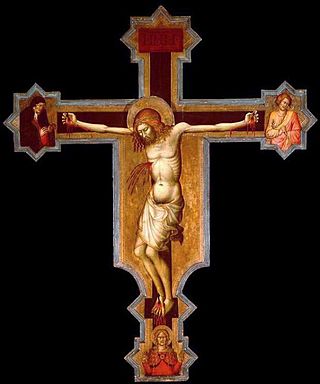
The Museum & Gallery, Inc. is currently located on the campus of Bob Jones University in Greenville, South Carolina. It was established in 1951, and focuses on sacred art, mainly European Old Master paintings, but also includes smaller collections of sculpture, furniture, architectural elements, textiles, Greek and Russian icons, and ancient artifacts. As of 2017, the museum is closed for a planned move to downtown Greenville, SC.
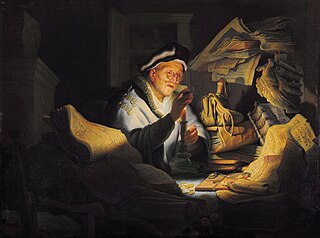
The Parable of the Rich Fool, also known as The Money Changer, is an oil painting on canvas of 1627 by Rembrandt, now in the Gemäldegalerie, Berlin. Produced early in the artist's career, it depicts the eponymous Biblical parable. The model for the figure is said to have been Rembrandt's father.

Supper at Emmaus is an undated oil on canvas painting by the Dutch or Flemish painter Matthias Stom. It was created when the artist was living in Rome, c. 1620-1640. It was bought by the town of Grenoble in 1826 and now hangs in Grenoble Museum. It depicts the scene described in the Gospel of Luke, when the Emmaus disciples recognize Jesus when He was breaking the bread.

King David is an oil on canvas painting by Matthias Stom, created c. 1633-1639, now held in the Musee des Beaux-Arts de Marseille. It is thought to have belonged to a set of four paintings of Old Testament kings. This group was itself part of a larger group of twelve works which also included the four Fathers of the Church and the four Evangelists, of which St Mark, St John and St Ambrose are now in the Musee des Beaux-Arts de Rennes.

The Judgement of Solomon is an oil on canvas painting by Matthias Stom, created c. 1640, representing the Judgement of Solomon. It is held in the Museum of Fine Arts, in Houston.

The Judgement of Solomon is an oil on canvas painting by Matthias Stom, created c. 1640, of the Judgement of Solomon, now in the Currier Museum of Art in Manchester, New Hampshire, which purchased it from the J.E. Safra collection at Sotheby's on 5 July 2017 for £428,750. Its palette, style and drapery are similar to other works painted by the artist while on Sicily such as The Stoning of St Stephen, now in the Palazzo Alliata Villafranca in Palermo - the artist settled on the island around 1640.
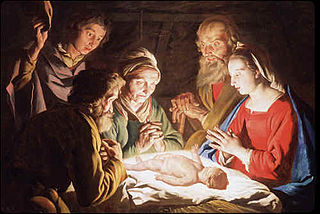
Adoration of the Shepherds may refer to several works by the Dutch artist Matthias Stom:
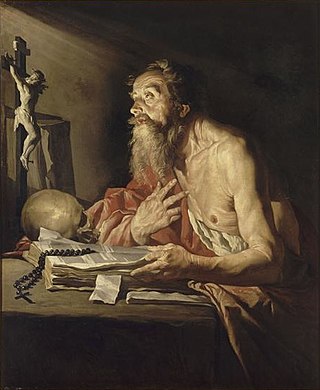
Saint Jerome is an oil-on-canvas painting by Dutch artist Matthias Stom. It was completed c. 1635 and is now in the Musee des Beaux Arts de Nantes, which bought it in 1810. Painted in a tenebrist style, it depicts Saint Jerome at a table in a darkened space. Before him there are a Bible, a rosary, a crucifix, and a skull. Jerome gazes in the direction of light which falls from the upper left.

The subject of the Adoration of the Magi was treated at least four times by the Dutch or Flemish painter Matthias Stom:
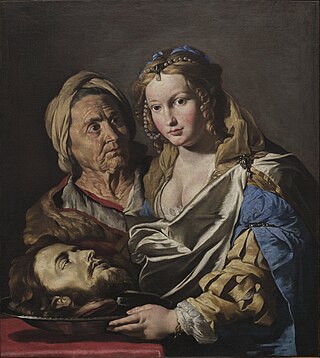
Salome with the Head of John the Baptist is an oil on canvas painting by the 17th century painter Matthias Stom. It is now in the Palazzo Bianco of the Musei di Strada Nuova in Genoa, to whose collections it was left in 1926 by E. L. Peirano. Typically of the painter's style, it combines Flemish attention to detail with the lessons he had learned from Caravaggio's work.

Salome Receives the Head of John the Baptist is an oil on canvas painting by Dutch artist Matthias Stom, probably painted around 1630–1632 in Rome. It is now held in the National Gallery, in London, to which it was presented by the Trustees of Sir Denis Mahon's Charitable Trust via the Art Fund in 2013.

The Incredulity of Saint Thomas is an oil painting on canvas by Matthias Stom, created c. 1640-1649. It is held in the Museo del Prado, in Madrid.

Isaac Blessing Jacob is an oil on canvas painting by Matthias Stom, created c. 1635, whilst the artist was on Sicily. It is now in the Barber Institute of Fine Arts, which purchased it in 1994. The sniffing dog indicates the work can also be read as an allegory of the five senses.


















